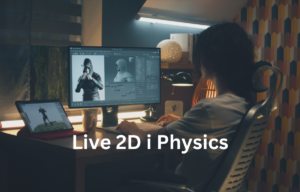In the world of animation and gaming, technological advancements continue to push the boundaries of creativity and interactivity. Among these advancements, Live 2D has emerged as a groundbreaking feature, revolutionizing how 2D characters and objects move and interact within digital environments. By introducing realistic physics to 2D assets, Live 2D i Physics enables developers, animators, and designers to create more immersive and engaging experiences.
This article delves into the concept of Live 2D i Physics, exploring its capabilities, applications, and the transformative impact it has had on digital animation and interactivity.
Understanding Live 2D and Its Core Features
What is Live 2D?
Live 2D is a software technology that enables animators and developers to create lifelike, dynamic 2D animations without the need to rely on traditional frame-by-frame techniques. It uses layered artwork to simulate three-dimensional movement, making characters appear more fluid and natural.
The Role of i Physics in Live 2D
Live 2D adds an extra layer of realism by incorporating physics-based simulations into the animation process. This feature ensures that elements such as hair, clothing, or accessories respond to virtual forces like gravity, wind, or collisions, creating a seamless and realistic motion effect.
How Live 2D i Physics Works
To understand the mechanics of Live 2D , it’s important to break down the core components that drive this innovative feature:
1. Physics Modeling
The i Physics engine simulates real-world physical properties such as inertia, elasticity, and damping. By assigning these properties to different layers or elements, animators can create complex, naturalistic motions.
2. Parameter Integration
Live 2D allows animators to connect physics-based properties to specific parameters, such as character movement or environmental changes. For example, a character’s hair might sway realistically when they tilt their head, thanks to the application of Live 2D i Physics.
3. Collision Detection
The software includes collision detection algorithms that prevent overlapping or unrealistic movements. This ensures that elements such as clothing or props interact believably with the character’s body and environment.
4. Real-Time Adjustments
One of the standout features of Live 2D is its ability to render physics simulations in real time, making it easier for animators to fine-tune movements during the design process.
Applications of Live 2D i Physics
The versatility of Live 2D has made it a popular choice in a variety of industries, from entertainment to education. Here are some of its most prominent applications:
1. Gaming
In gaming, Live 2D enhances character animations, making them more engaging and lifelike. Players can interact with characters whose movements respond dynamically to their actions, creating a richer gaming experience.
2. Virtual YouTubers (VTubers)
VTubers are one of the biggest beneficiaries of Live 2D . By applying realistic physics to facial expressions, hair, and accessories, VTubers can achieve a more immersive and natural presence during live streams.
3. Mobile Apps
Many mobile apps, especially in the realm of storytelling and virtual interactions, utilize Live 2D to add depth to character animations and interface elements.
4. Animated Films and Shorts
While traditional 2D animation still thrives, Live 2D allows filmmakers to incorporate realistic effects without the time-intensive process of hand-drawing every frame.
5. Educational Content
Educational animations benefit from the interactivity and realism provided by Live 2D , which can make learning more engaging and effective.
Advantages of Live 2D
The integration of Live 2D into animation and design workflows offers several benefits:
1. Enhanced Realism
By simulating natural physical movements, Live 2D creates animations that feel more organic and believable, bridging the gap between 2D and 3D visuals.
2. Time Efficiency
Unlike traditional methods that require frame-by-frame adjustments, physics-based simulations reduce the time needed to create complex animations.
3. Increased Interactivity
Interactive elements powered by Live 2D provide users with a more engaging experience, whether in games, apps, or educational tools.
4. Cost-Effectiveness
For creators working with limited budgets, Live 2D offers a cost-effective way to produce high-quality animations without investing in 3D modeling.
5. Flexibility Across Platforms
The software supports a wide range of platforms, including PC, mobile, and web, making it accessible to creators and audiences worldwide.
Challenges in Implementing Live 2D
While Live 2D i Physics offers numerous advantages, it also comes with certain challenges that creators must address:
1. Learning Curve
For animators new to Live 2D, mastering the physics engine and parameter settings can be daunting. Training and practice are essential to unlock its full potential.
2. Hardware Requirements
Simulating physics in real time can be resource-intensive, requiring robust hardware for smooth performance during the design and rendering stages.
3. Balancing Realism and Art Style
Too much realism in a 2D context can clash with stylized art, making it important to strike a balance between physics accuracy and artistic intent.
Best Practices for Using Live 2D i Physics
To maximize the potential of Live 2D , creators can follow these best practices:
1. Plan Ahead
Define the scope and purpose of your animation before diving into physics settings. Knowing which elements require dynamic motion will streamline the process.
2. Start Small
Begin with simple simulations, such as hair movement or a bouncing ball, to familiarize yourself with the tools before tackling complex projects.
3. Experiment with Parameters
Adjust physics properties like gravity, damping, and elasticity to achieve the desired level of realism for each element.
4. Test in Real-Time
Regularly preview your animations to ensure that movements look natural and interact appropriately with other elements.
5. Seek Feedback
Collaborate with peers or test your animations with target audiences to gather feedback and refine your designs.
The Future of Live 2D i Physics
As technology continues to evolve, Live 2D is poised to become even more sophisticated, offering creators new possibilities for innovation. Key trends to watch include:
1. AI Integration
Artificial intelligence could further enhance physics simulations, enabling more accurate and adaptive motion dynamics.
2. Expanded Accessibility
Future updates may simplify the user interface and reduce hardware demands, making Live 2D accessible to a broader range of creators.
3. Cross-Platform Compatibility
Enhanced support for AR, VR, and mixed reality platforms will allow creators to bring their 2D animations into immersive environments.
Live 2D has transformed the landscape of 2D animation, making it possible to achieve levels of realism and interactivity once reserved for 3D graphics. From gaming to VTubing, its applications are as diverse as its users.
By understanding the tools, mastering best practices, and embracing the creative freedom offered by Live 2D i Physics, animators and developers can unlock a world of possibilities in digital design. As the technology continues to advance, its impact on the industry will only grow, shaping the future of how we create and experience 2D animations.
Would you like to explore additional topics or technical guides related to Live 2D or animation software? Visit our website.












